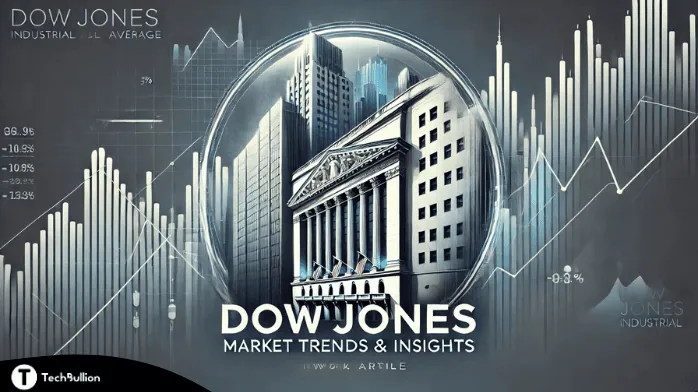
The Dow Jones Industrial Average (DJIA), often referred to simply, is one of the most widely recognized stock market indices in the world. For over a century, it has served as a key barometer of the health and performance of the U.S. economy. Whether you’re a seasoned investor or a financial novice, understanding is essential to grasp the intricacies of the stock market and its influence on the global financial landscape.
In this article, we will explore the origins, significance, and mechanics of the Dow Jones, as well as its impact on global markets, investment strategies, and everyday economic life.
What is the Dow Jones Industrial Average?
The Dow Jones Industrial Average (DJIA) is a stock market index that tracks the performance of 30 major publicly traded companies in the United States. These companies span various industries, including technology, finance, healthcare, and consumer goods, making the DJIA a representative snapshot of the U.S. economy.
The Dow is often used by analysts, investors, and policymakers as an indicator of economic trends and market sentiment. While it represents only a small portion of the total stock market, its influence is unparalleled, earning it the nickname “the barometer of Wall Street.”
The History of the Dow Jones
The Dow Jones Industrial Average was created in 1896 by Charles Dow, a journalist and co-founder of Dow Jones & Company, along with his business partner Edward Jones. Initially, the index included just 12 companies, most of which were in the industrial sector, reflecting the industrial revolution’s dominance during that era.
Key Milestones in Dow Jones History:
- First Publication (1896): The Dow opened at 40.94 points, with companies like American Cotton Oil and Chicago Gas on the list.
- Great Depression (1929): The Dow suffered one of its largest declines during the 1929 stock market crash, marking the onset of the Great Depression.
- Post-War Boom (1950s): The index experienced steady growth after World War II, reflecting a robust post-war economy.
- Modern Era (1987): The infamous Black Monday in October 1987 saw the Dow drop by 22.6% in a single day, the largest one-day percentage decline in history.
- Digital Age (2000s): Technology giants like Microsoft and Apple became part of the index, signaling a shift from industrial to tech-driven markets.
How is the Dow Jones Calculated?
Unlike other indices, the Dow Jones uses a price-weighted methodology, which means that companies with higher stock prices have a greater influence on the index’s movement.
Steps in Calculation:
- Add the stock prices of all 30 companies in the index.
- Divide the total by a special figure known as the Dow Divisor, which adjusts for stock splits, dividends, and other market factors.
This calculation method has faced criticism for being outdated, as it disproportionately weights high-priced stocks regardless of the company’s overall market value. Nonetheless, it remains the defining characteristic of the DJIA.
The Companies in the Dow Jones
The 30 companies included in the Dow Jones Industrial Average are selected to represent the most significant sectors of the U.S. economy. These companies are household names, often leaders in their respective industries.
Examples of Current Dow Components:
- Technology: Apple, Microsoft, Intel
- Finance: JPMorgan Chase, Goldman Sachs
- Healthcare: Johnson & Johnson, Merck
- Consumer Goods: Coca-Cola, Procter & Gamble
- Energy: Chevron
The composition of the Dow is not static; it evolves to reflect changing economic trends. For example, companies like General Electric, a founding member of the index, were eventually replaced as newer industries gained prominence.
The Significance of the Dow Jones
1. Indicator of Market Health
The Dow Jones is often viewed as a shorthand measure of the U.S. stock market’s overall performance. When the Dow rises, it’s typically interpreted as a sign of investor confidence and economic growth. Conversely, a decline can indicate economic uncertainty or bearish market sentiment.
2. Economic Predictor
Historically, the Dow has been a reliable predictor of economic trends. For instance, sustained declines in the index often precede recessions, while consistent growth aligns with periods of economic expansion.
3. Influence on Global Markets
Given the central role of the U.S. economy in global finance, movements in the Dow Jones often ripple through international markets. A major drop in the Dow can trigger sell-offs in European and Asian markets, underscoring its global significance.
Criticisms of the Dow Jones
While the Dow Jones remains an iconic market index, it is not without its critics.
1. Price-Weighted Bias
As mentioned earlier, the Dow’s price-weighted methodology means that a company’s stock price, rather than its market capitalization, determines its influence on the index. This can lead to distortions in representing true market performance.
2. Limited Scope
With only 30 companies, the Dow does not capture the full breadth of the U.S. stock market, which includes thousands of publicly traded companies. Other indices, like the S&P 500, are often viewed as more comprehensive.
3. Industrial Focus
Despite its evolution, the Dow’s origins in the industrial sector still influence its composition, making it less reflective of emerging industries like renewable energy or biotechnology.
The Dow Jones and Investment Strategies
Investors often use the Dow Jones as a benchmark for evaluating portfolio performance or as a guide for investment decisions.
1. Index Funds and ETFs
Many investors choose to invest in funds that track the Dow Jones, such as the SPDR Dow Jones Industrial Average ETF Trust (DIA). These funds offer exposure to the index’s performance without the need to buy individual stocks.
2. Diversification
While the Dow is a useful tool for gauging market trends, savvy investors often look beyond it to achieve diversification. This includes exploring other indices, international markets, and asset classes like bonds and real estate.
3. Long-Term Perspective
Historical data shows that the Dow has delivered consistent growth over the long term, despite short-term volatility. This makes it an attractive option for long-term investors seeking steady returns.
Notable Dow Jones Milestones
1. Crossing 10,000 Points (1999)
The Dow broke the 10,000-point barrier during the dot-com boom, symbolizing a new era of economic growth.
2. Reaching 20,000 Points (2017)
This milestone highlighted the resilience of the U.S. economy amid global uncertainties, including political shifts and trade tensions.
3. Surpassing 30,000 Points (2020)
The index crossed 30,000 points for the first time, even as the world grappled with the economic fallout of the COVID-19 pandemic.
The Future of the Dow Jones
The Dow Jones continues to evolve, reflecting changes in the economy and market dynamics. As emerging industries like green energy, artificial intelligence, and biotechnology grow in importance, the index may undergo further transformations to stay relevant.
Additionally, technological advancements and data-driven investment strategies are reshaping how the Dow is analyzed and utilized by investors worldwide.
Conclusion: The Enduring Legacy of the Dow Jones
The Dow Jones Industrial Average has stood the test of time as a symbol of economic power, resilience, and innovation. While it has its limitations, its influence on global markets and its role as a benchmark for investors remain unmatched.
Whether you’re tracking market trends, planning investment strategies, or simply trying to understand the economy, offers valuable insights into the ever-changing world of finance. As we move into the future, the index will undoubtedly continue to reflect the evolution of industries, technologies, and the global economy itself.







